Weekly Recap
US stocks closed higher after a volatile week in which many trade-related headlines continued to drive sentiment. Equities opened sharply lower last week, extending losses from the previous week as risk-off sentiment intensified amid Trump’s latest round of tariffs.
However, on Wednesday, Trump. Amid signs of disruption in the bond market, Trump announced a 90-day pause on individual country tariffs for those who had not retaliated to allow negotiations. Stocks surged, with the Nasdaq 100 gaining over 12% in its second-best day ever.
However, Trump ramped up tariffs on China several times across the week to a total of 145%, and China responded by increasing tariffs on the US to 125%. The escalating trade war between the world’s two largest economies could impact global growth, pulling stocks and oil lower again on Thursday before gains on Friday in a rollercoaster of a week. Once the dust had settled, the S&P 500 closed 5.7% higher, and the Nasdaq closed 7.3% higher.
Safe-haven demand rose amid the uncertainty, with gold reaching record highs of +6.5% last week to over $3200. The Japanese yen and Swiss franc have also outperformed, while the USD fell to its lowest since April 2022.
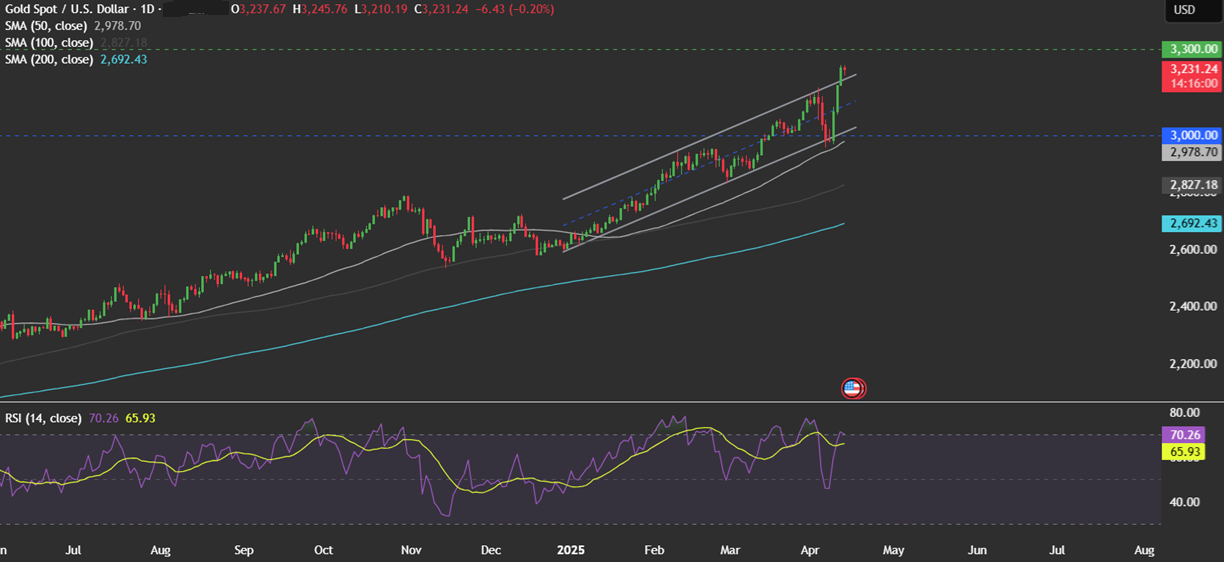
Aside from the USD selloff, the biggest story came from the US treasury market, which saw the US 10-year treasury yield jump by the most in two decades. US treasuries are typically safe havens and risk-free assets. However, the uncertainty coming from the Trump administration is fueling a selloff in US government debt.
Trump trade tariffs & Powell speech (Wednesday)
Trump’s plans for trade tariffs will remain in focus and continue to drive sentiment. Over the weekend, the White House later denied rumors that chips, phones, and computers would be exempt from the steep Chinese trade tariffs.
Fed Chair Powell is due to speak this week and could provide insight into what these trade tariff developments mean for the Fed and its stance on rates amid increased volatility and uncertainty. The Fed is unlikely to step in for now with a rate cut, but liquidity tools are on the table. The market has reined in Fed rate cut bets, although it still sees a cut in June. A cautious Fed could weigh on stocks. However, a sense that the Fed is prepared to step in if needed could help boost the mood.
The Nasdaq has seen elevated volatility over the past few weeks. This week, a holiday-shortened week, may see a calmer trend.
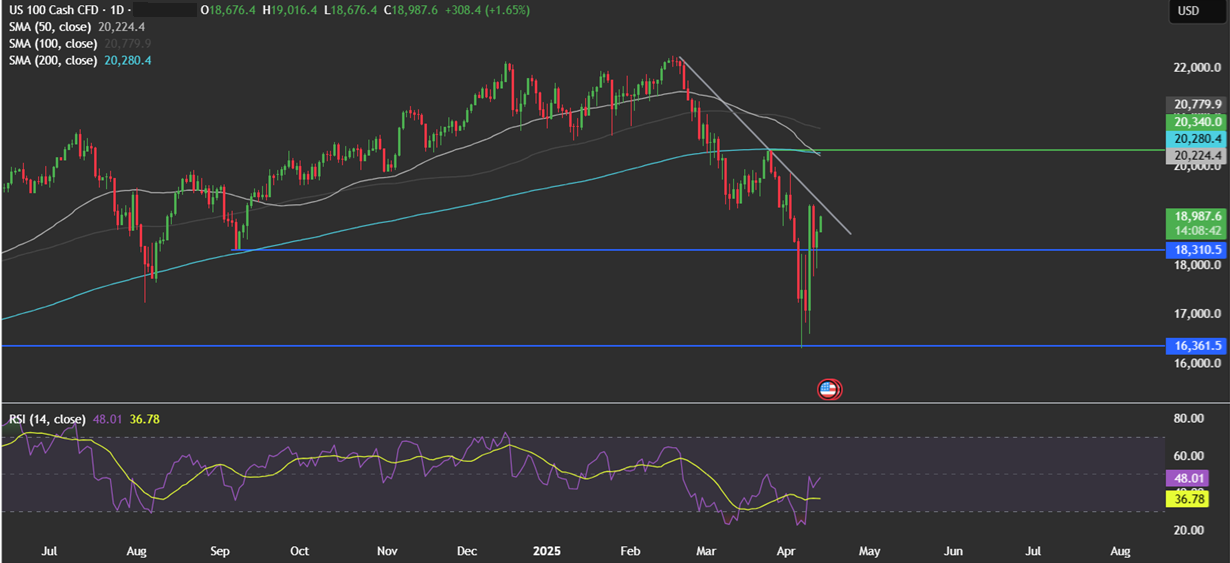
BoC rate decision (Wednesday)
The BoC will meet on April the 16th. The meeting comes after the Bank of Canada cut rates by 25 basis points down to 2.75% in the March meeting, the second rate reduction this year after cutting by 25 basis points in January.
The market is pricing in just a 28% probability of a further 25 basis point rate cut this week, which would take the policy rate to 2.5%; another 25 basis point rate cut is not priced in until September, although a potential move on June 4th is considered a coin toss at this point. After seven straight rate cuts, the Bank of Canada has adopted a more neutral policy stance, given concerns about tariff-induced inflation.
Ahead of the meeting, Canadian economic data has topped expectations more often than not in recent months, a different story to the US.
The USD/CAD is trading at its lowest level since November last year, thanks in part to the weakness of the U.S. dollar.
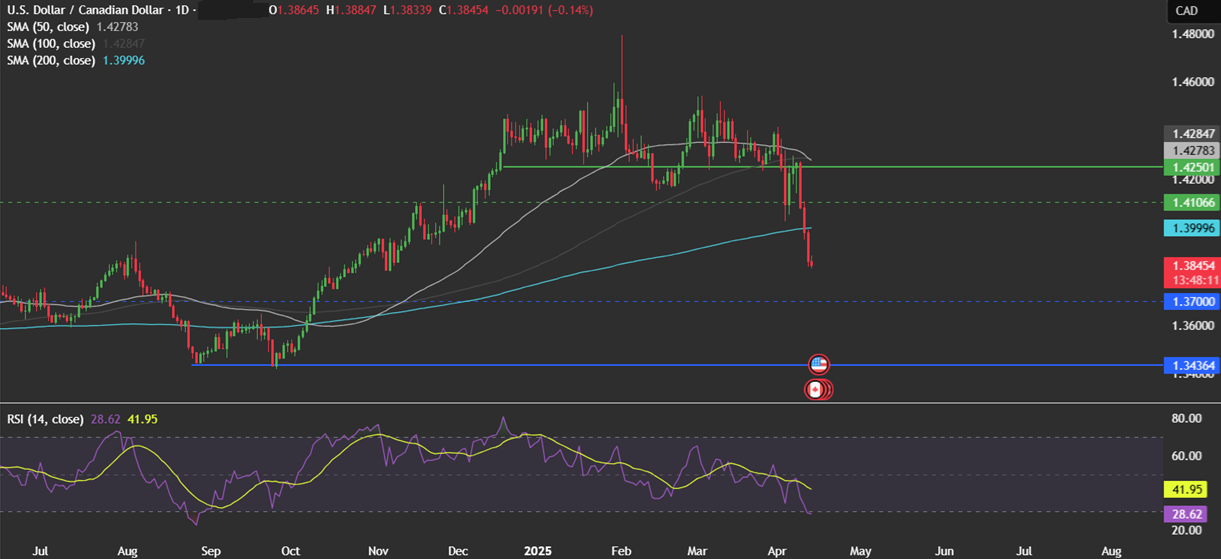
UK CPI (Wednesday)
UK CPI headline has shown few signs of cooling in recent months, highlighting the challenges that the Bank of England faces as it looks for opportunities to cut interest rates. The central bank has reduced rates three times since August, totaling 75 basis points. However, CPI has risen from 1.7% to 3% in January before easing to 2.8% annually in February; meanwhile, core inflation remains well above the 2% target at 3.5%, and service sector inflation is still elevated at 5%.
The Bank of England has forecasted that headline inflation could rise as much as 3.7% in Q3 before falling back towards the end of the year. However, the threats of trade tariffs could exert further upward pressure on prices but may also hurt the growth outlook. As a result, the increase in inflation could be offset by concerns over the longer-term outlook for growth and price pressures.
GBP/USD trades at its highest level amid USD weakness. GBP/USD could rise further if UK CPI comes in ahead of the 2.8% forecast.
Hot inflation data could lift GBP/USD further towards 1.32.

US Retail Sales (Wednesday)
US consumer spending had proven to be relatively resilient until January, with a 0.6% fall at the start of the year and some concerns that the US economy was starting to slow. There was a modest rebound of 0.2% in February, although this was below expectations. The control group, which directly impacts USD, rose by more than expected at 1%.
February’s numbers suggest the US economy remains resilient, although consumer confidence is painting a different picture with a sharp deterioration since the start of the year. In March, U.S. consumer confidence slowed to 92.9, a three-year low.
While the jobs market is holding up, consumers are nervous about the disruption the Trump administration is bringing. However, sales are expected to rise 1.3% Month over Month as consumers rush to buy before tariffs hit and prices increase. Strong retail sales could give the USD a brief boost.
The USD/JPY has fallen to its lowest level since late September.
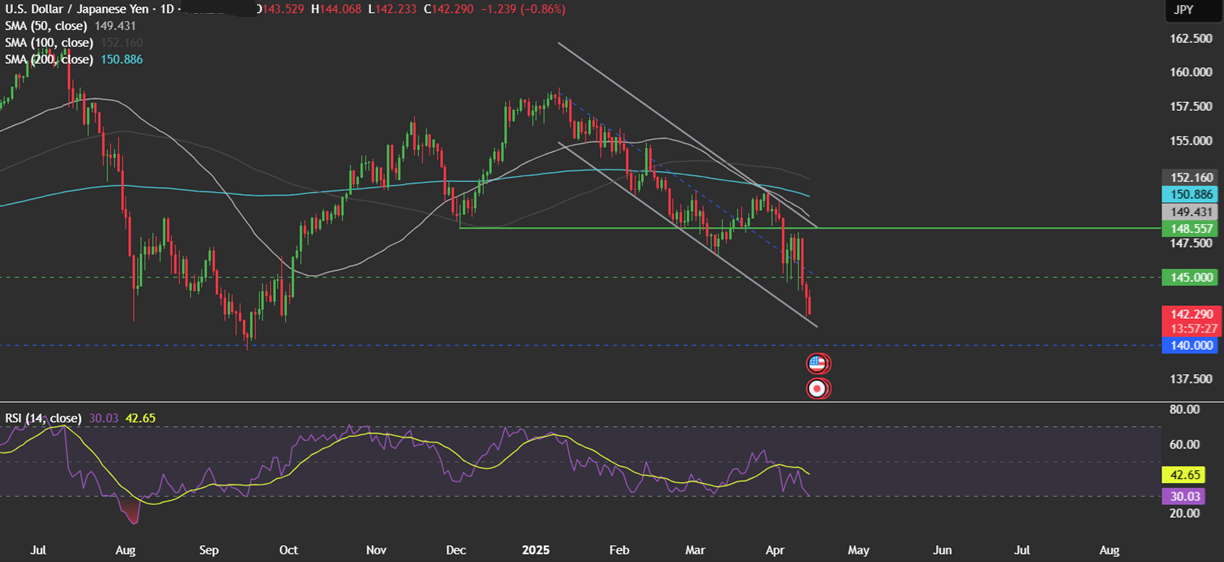
ECB Rate decision (Thursday)
The ECB is expected to cut interest rates by 25 basis points in the meeting on April 17. This is being priced in with a 90% likelihood, up from 70% before Trump’s so-called “liberation day” trade tariff announcements. This would mark the seventh straight rate cut with another expected in June
The outlook for the European Union has deteriorated after Trump applied universal 10% trade tariffs and 25% tariffs on auto, steel, and aluminium tariffs. These could cause a negative demand shock, creating significantly deflationary pressures within the European region.
Growth will be even more of an ECB concern and could prompt a more dovish tone from policymakers, a notable change from more hawkish expectations after the ECB rate cut in March.
Eurozone inflation fell 2.2% in March, close to the ECB’s 2% target. See graph for EUR/USD.
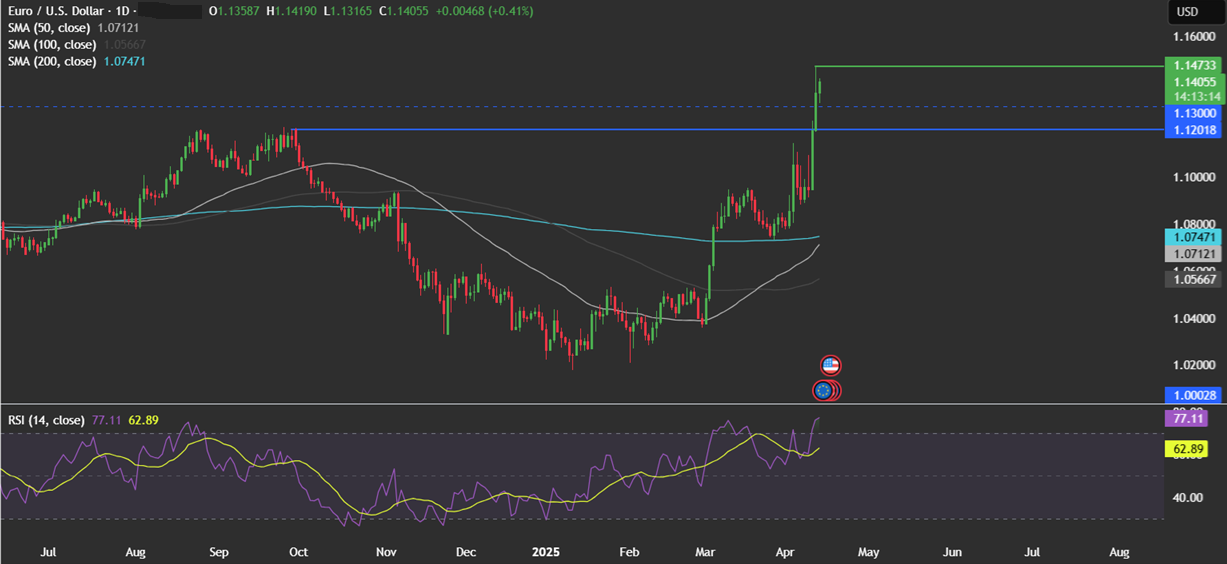
Earnings
US earnings ramp up this week with numbers from more major banks, including Citigroup and Goldman Sachs. Streaming giant Netflix will also release its figures. This earnings season, there will be more focus than usual on company outlooks, even as the extreme uncertainty around tariffs could mean less confidence or even no guidance.
Widespread tariffs could hurt corporate bottom lines both directly and indirectly. Higher import costs mean more pressure on margins. Some companies could absorb the increased costs, but others may pass them on to customers. A slowdown in consumer spending could affect some sectors, such as retail. US firms may offer weak guidance for the rest of the year or withdraw it altogether. Meanwhile, strong Q1 figures could provide some respite and a distraction from the current tariff saga.
The Dow Jones has recovered from its low, but the downtrend remains for now.
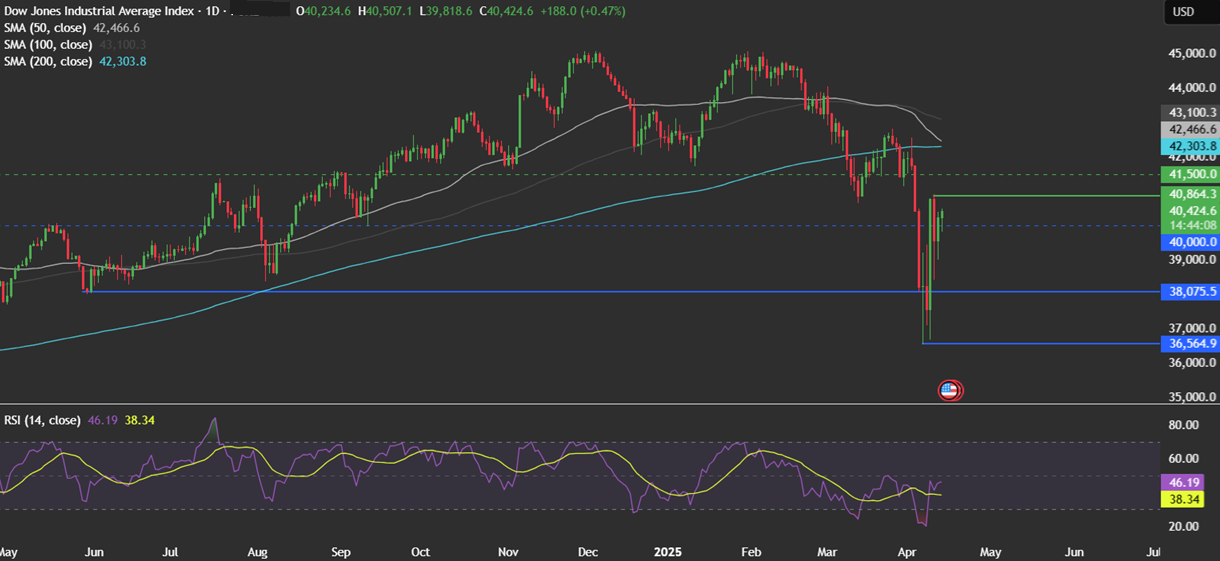
The content provided here is for informational purposes only. It is not intended as personal investment advice and does not constitute a solicitation or invitation to engage in any financial transactions, investments, or related activities. Past performance is not a reliable indicator of future results.
The financial products offered by the Company are complex and come with a high risk of losing money rapidly due to leverage. These products may not be suitable for all investors. Before engaging, you should consider whether you understand how these leveraged products work and whether you can afford the high risk of losing your money.
The Company does not accept clients from the Restricted Jurisdictions as indicated in our website/ T&C. Some services or products may not be available in your jurisdiction.
The applicable legal entity and its respective products and services depend on the client’s country of residence and the entity with which the client has established a contractual relationship during registration.




